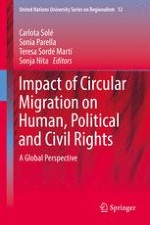This volume addresses the topic of circular migration with regard to its multiple dimensions and human, political and civil rights implications from a global perspective. It combines theoretical and empirical studies and presents different case studies illustrating circular migration patterns and policies in different world regions. Circular migration processes – understood as the back-and-forth movement of people between countries and regions- form part of the changing nature of migration movements across the world at the beginning of the 21st century. Over the past decades, international, regional and internal migration flows have shown a quantitative increase and have changed in scope, context, origin and nature. Migration projects are every time more open-ended, multi-directional and flexible and often include some type of circularity. Instead of mere “push-pull-scenarios”, people migrate for many different reasons, including personal, family, professional, academic or political ones. In the 21st century migration journeys and the reasons underlying them are multiple and more diverse than ever before.
